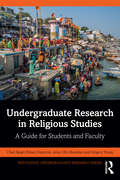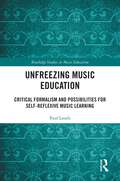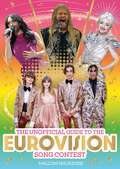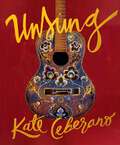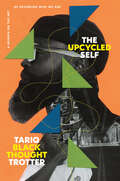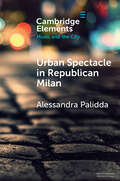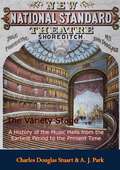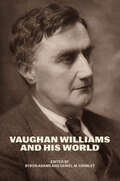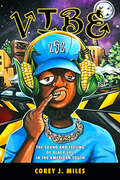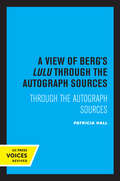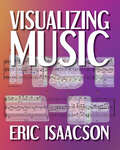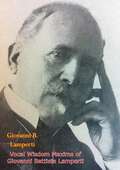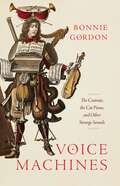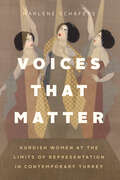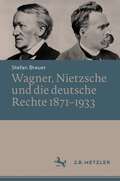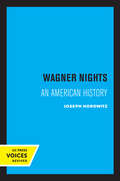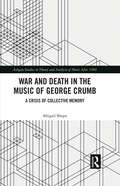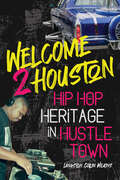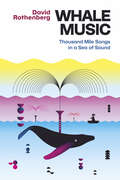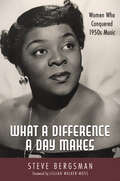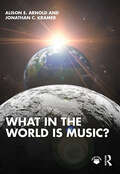- Table View
- List View
Undergraduate Research in Religious Studies: A Guide for Students and Faculty (Routledge Undergraduate Research Series)
by Ruben Dupertuis Chad Spigel Jenny Olin Shanahan Gregory YoungUndergraduate Research in Religious Studies provides students and faculty with an invaluable guide to conducting research projects across all areas in the study of religion. With an emphasis on student-faculty collaboration, this concise book addresses the key areas, methods, and practical issues to inform the practice of original undergraduate research across a wide range of subdisciplines. In fourteen short chapters, the authors lay out the stages of the research process and different research methodologies; discuss approaches, examples, and ethical issues particular to religious studies; and address the unique value and challenges of collaborative research with undergraduate students, including case studies of student-faculty collaboration. Designed to be utilized by students and faculty as both a textbook and reference, this book offers an essential resource for all those engaging in or leading undergraduate research across religious studies.
Undergraduate Research in Religious Studies: A Guide for Students and Faculty (Routledge Undergraduate Research Series)
by Ruben Dupertuis Chad Spigel Jenny Olin Shanahan Gregory YoungUndergraduate Research in Religious Studies provides students and faculty with an invaluable guide to conducting research projects across all areas in the study of religion. With an emphasis on student-faculty collaboration, this concise book addresses the key areas, methods, and practical issues to inform the practice of original undergraduate research across a wide range of subdisciplines.In fourteen short chapters, the authors lay out the stages of the research process and different research methodologies; discuss approaches, examples, and ethical issues particular to religious studies; and address the unique value and challenges of collaborative research with undergraduate students, including case studies of student-faculty collaboration. Designed to be utilized by students and faculty as both a textbook and reference, this book offers an essential resource for all those engaging in or leading undergraduate research across religious studies.
Unfreezing Music Education: Critical Formalism and Possibilities for Self-Reflexive Music Learning (Routledge Studies in Music Education)
by Paul LouthUnfreezing Music Education argues that discussing the conflicting meanings of music should occupy a more central role in formal music education and music teacher preparation programs than is currently the case. Drawing on the critical theory of the Frankfurt School, the author seeks to take a dialectical approach to musical meaning, rooted in critical formalism, that avoids the pitfalls of both traditional aesthetic arguments and radical subjectivity. This book makes the case for helping students understand that the meaning of musical forms is socially constructed through a process of reification, and argues that encouraging greater awareness of the processes through which music’s fluid meanings become hidden will help students to think more critically about music. Connecting this philosophical argument with concrete, practical challenges faced by students and educators, this study will be of interest to researchers across music education and philosophy, as well as post-secondary music educators and all others interested in aesthetic philosophy, critical theory, cultural studies, or the sociology of music and music education.
The Unofficial Guide to the Eurovision Song Contest: The must-have guide for Eurovision 2023!
by Malcolm MackenzieThe must-have guide for Eurovision fans! Packed full of trivia, party games, high scores and nil points. Plus 32 pages of full colour photos.Hello, bonjour, Hola! It's Eurovision calling and what better way to celebrate the flamboyant show than with this ultimate (and unofficial) guide to the biggest singing contest in the world!How well do you know the Eurovision Song Contest? With this unofficial guide you'll know your Conchita Wurst's from your Alexander Rybanks, why we all love Kalush Orchestra, what made Sam Ryder the nation's sweetheart and which band takes top of the polls - Abba vs. Måneskin - or could it even be Scooch?This ultimate guide recaps the highs and lows of the decades old contest including its bangers and ballads, most shocking moments, photos of the worst dressed acts, top scoring countries - and those who score nil points, and plenty of games to play at your Eurovision party. Eurovision bingo anyone?
Unsung: A Compendium of Creativity
by Kate CeberanoA beautiful illustrated memoir from beloved Australian musician Kate Ceberano, featuring her inspirational song lyrics, stories, paintings and embroidery, and celebrating four decades of songwriting and recording on the release of her 30th album. Kate Ceberano is used to a hush descending as she draws breath to release that magnificent voice but when the whole world quietened in 2020, she found the silence disorientating. Without an audience or long hours of travel with her tribe of musicians, there was time to think. But what does an artist do when they can&’t make art? They find a way. With characteristic passion, abundance and joy, Kate liberated her unsung songs. They flowed through her paintbrush as she embellished guitars, her needle as she stitched quilts to envelop her beloveds and her pen as she unfurled stories, poems and songs. In Unsung Kate muses on the people and experiences that have inspired her, on what has humbled her, what hurts and what sustains. This is the story of a powerful woman in her prime, but also of a reflective, romantic and vulnerable artist making sense of the universe. It&’s proof of a lifetime lived in music. It&’s a tribute to songs, wherever they come from and wherever they go.
The Upcycled Self: A Memoir on the Art of Becoming Who We Are
by Tariq Trotter&“One of hip-hop&’s greatest MCs, unpacking his harrowing, remarkable journey in his own words, with enough insights for two lifetimes.&”—Lin-Manuel Miranda, award-winning songwriter, producer, director, and creator of In the Heights and Hamilton From one of our generation&’s most powerful artists and incisive storytellers comes a brilliantly crafted work about the art—and war—of becoming who we are.upcycle verbup·cy·cle ˈəp-ˌsī-kəl: to recycle (something) in such a way that the resulting product is of a higher value than the original item: to create an object of greater value from (a discarded object of lesser value)Today Tariq Trotter—better known as Black Thought—is the platinum-selling, Grammy-winning co-founder of The Roots and one of the most exhilaratingly skillful and profound rappers our culture has ever produced. But his story begins with a tragedy: as a child, Trotter burned down his family&’s home. The years that follow are the story of a life snatched from the flames, forged in fire. In The Upcycled Self, Trotter doesn&’t only narrate a riveting and moving portrait of the artist as a young man, he gives readers a courageous model of what it means to live an examined life. In vivid vignettes, he tells the dramatic stories of the four powerful relationships that shaped him—with community, friends, art, and family—each a complex weave of love, discovery, trauma, and loss. And beyond offering the compellingly poetic account of one artist&’s creative and emotional origins, Trotter explores the vital questions we all have to confront about our formative years: How can we see the story of our own young lives clearly? How do we use that story to understand who we&’ve become? How do we forgive the people who loved and hurt us? How do we rediscover and honor our first dreams? And, finally, what do we take forward, what do we pass on, what do we leave behind? This is the beautifully bluesy story of a boy genius&’s coming-of-age that illuminates the redemptive power of the upcycle.
Urban Spectacle in Republican Milan: Pubbliche feste at the Turn of the Nineteenth Century (Elements in Music and the City)
by Alessandra PaliddaAt the turn of the nineteenth century, Lombardy and its capital Milan lived through a season of intense social and political change, especially in the passage between Austrian Monarchy and Napoleonic republics (1796-1799, and 1800-1802). While affecting cultural production on all levels, this passage occasioned a significant change in terms of public celebration, with republican festivals and other celebratory occasions coming from revolutionary France being reframed amongst Milanese specificities. After establishing a solid historical and aesthetic background to Lombardy in this delicate period, to the revolutionary models and to the Milanese substrate, this Element aims at reconstructing and describing the main features of the French republican festivals in Milan, and their impact on the city's landscape, soundscape and self-representation. It will also conclude by offering some reflections on these events' consequences on the following century's patriotism/nationalism and cultural production, reinstating them as an interesting, albeit forgotten case study.
The Variety Stage: A History of the Music Halls from the Earliest Period to the Present Time
by A. J. Park Charles Douglas StuartMusic hall was a type of British theatrical entertainment that was popular from the early Victorian era, beginning around 1850. It faded away after 1918 as the halls rebranded their entertainment as variety. Perceptions of a distinction in Britain between bold and scandalous Music Hall and subsequent, more respectable Variety differ. Music hall involved a mixture of popular songs, comedy, speciality acts, and variety entertainment. The term is derived from a type of theatre or venue in which such entertainment took place. In North America vaudeville was in some ways analogous to British music hall, featuring rousing songs and comic acts.“To the general reader, as well as to the thoughtful observer of the social institutions of the English people, the story of the rise, progress and present condition of Variety Stage in this country presents features of peculiar attraction.In The History of the Variety Stage they have endeavoured to deal in a bright, chatty and anecdotal manner, not only with the Music Halls of the past and present, but also with the picturesque and variegated profession which has called them into existence, and while presenting to the statistician, the antiquarian, and the student of domestic history, a substantial and painstaking work of research, they have tried to render at the same time a graphic panorama of the variety world as it was and as it is today.”-Preface.
Vaughan Williams and His World (The Bard Music Festival)
by Byron Adams and Daniel M. GrimleyA biography of Ralph Vaughan Williams, published in collaboration with the Bard Music Festival. Ralph Vaughan Williams (1872–1958) was one of the most innovative and creative figures in twentieth-century music, whose symphonies stand alongside those of Sibelius, Nielsen, Shostakovich, and Roussel. After his death, shifting priorities in the music world led to a period of critical neglect. What could not have been foreseen is that by the second decade of the twenty-first century, a handful of Vaughan Williams’s scores would attain immense popularity worldwide. Yet the present renown of these pieces has led to misapprehension about the nature of Vaughan Williams’s cultural nationalism and a distorted view of his international cultural and musical significance. Vaughan Williams and His World traces the composer’s stylistic and aesthetic development in a broadly chronological fashion, reappraising Vaughan Williams’s music composed during and after the Second World War and affirming his status as an artist whose leftist political convictions pervaded his life and music. This volume reclaims Vaughan Williams’s deeply held progressive ethical and democratic convictions while celebrating his achievements as a composer.
Vibe: The Sound and Feeling of Black Life in the American South (Margaret Walker Alexander Series in African American Studies)
by Corey J. MilesWhere exactly does the South begin and end? Current maps are too rigid to account for the ways Black people have built the South while being simultaneously excluded from it. Drawing from the different ways Black artists in the 2-5-2 area code in North Carolina use "vibe" as a mode of knowing and communication, author Corey J. Miles illustrates how Black feeling and unfeeling offer entry points into the contemporary South that challenge static and monolithic notions of the region. Placing the local artists in conversation with other southern cultural creators such as 2 Chainz, Rod Wave, and Rapsody, these ethnographic narratives demonstrate that there are multiple Souths, with overlapping and distinct commitments to working through pain, sound, and belonging. In Vibe: The Sound and Feeling of Black Life in the American South, Miles narrates how southern Black sound, feeling, and being is constantly policed, surveilled, and criminalized. In doing so, he re-narrates the region as the "carceral South," to capture the ways people in the South and beyond can feel the emotional weight of the criminalization of Blackness. Pain music, a subgenre of trap music, is used to take the listener to moments of violence to allow them to hear the desires, anger, and silences that bind Black life in community. Through conceptions of ratchet, hood, and ghetto, Black artists turn away from respectable images and unmap the South. In trap music, they move the South to a space where multiple modes of being find respect and care.
A View of Berg's Lulu: Through the Autograph Sources
by Patricia HallAfter 50 years of analysis we are only beginning to understand the quality and complexity of Alban Berg's most important twelve-tone work, the opera Lulu. Patricia Hall's new book represents a primary contribution to that understanding—the first detailed analysis of the sketches for the opera as well as other related autograph material and previously inaccessible correspondence to Berg. In 1959, Berg's widow deposited the first of Berg's autograph manuscripts in the Austrian National Library. The complete collection of autographs for Lulu was made accessible to scholars in 1981, and a promising new phase in Lulu scholarship unfolded. Hall begins her study by examining the format and chronology of the sketches, and she demonstrates their unique potential to clarify aspects of Berg's compositional language. In each chapter Hall uses Berg's sketches to resolve a significant problem or controversy that has emerged in the study of Lulu. For example, Hall discusses the dramatic symbolism behind Berg's use of multiple roles and how these roles contribute to the large-scale structure of the opera. She also revises the commonly held view that Berg frequently invoked a free twelve-tone style. Hall's innovative work suggests important techniques for understanding not only the sketches and manuscripts of Berg but also those of other twentieth-century composers. This title is part of UC Press's Voices Revived program, which commemorates University of California Press’s mission to seek out and cultivate the brightest minds and give them voice, reach, and impact. Drawing on a backlist dating to 1893, Voices Revived makes high-quality, peer-reviewed scholarship accessible once again using print-on-demand technology. This title was originally published in 1996.
Visualizing Music
by Eric IsaacsonTo feel the emotional force of music, we experience it aurally. But how can we convey musical understanding visually?Visualizing Music explores the art of communicating about music through images. Drawing on principles from the fields of vision science and information visualization, Eric Isaacson describes how graphical images can help us understand music. By explaining the history of music visualizations through the lens of human perception and cognition, Isaacson offers a guide to understanding what makes musical images effective or ineffective and provides readers with extensive principles and strategies to create excellent images of their own. Illustrated with over 300 diagrams from both historical and modern sources, including examples and theories from Western art music, world music, and jazz, folk, and popular music, Visualizing Music explores the decisions made around image creation. Together with an extensive online supplement and dozens of redrawings that show the impact of effective techniques, Visualizing Music is a captivating guide to thinking differently about design that will help music scholars better understand the power of musical images, thereby shifting the ephemeral to material.
Vocal Wisdom Maxims of Giovanni Battista Lamperti [1931 edition]
by Giovanni B. LampertiGiovanni Battista Lamperti (1839 -1910) was an Italian singing teacher and son of the singing teacher Francesco Lamperti. He is source for Vocal Wisdom: Maxims of Giovanni Battista Lamperti (1931). His preferred teaching arrangement was having three or four students present at each lesson: each would get their turn while the others observed and learned thereby. He was said to be a strict, exacting instructor not given to flattery, but who enthusiastically praised his students upon exceptional achievement. Many of Giovanni's students became international opera stars including Irene Abendroth, Marcella Sembrich, Ernestine Schumann-Heink, Paul Bulss, Roberto Stagno, David Bispham and Franz Nachbaur. The Technics of Bel Canto is the only book (other than the maxims recalled and published posthumously by his pupil William E. Brown) that Giovanni ever wrote on his method.-Print ed.
Voice Machines: The Castrato, the Cat Piano, and Other Strange Sounds
by Bonnie GordonAn exploration of the castrato as a critical provocation to explore the relationships between sound, music, voice instrument, and machine. Italian courts and churches began employing castrato singers in the late sixteenth century. By the eighteenth century, the singers occupied a celebrity status on the operatic stage. Constructed through surgical alteration and further modified by rigorous training, castrati inhabited human bodies that had been “mechanized” to produce sounds in ways that unmechanized bodies could not. The voices of these technologically enhanced singers, with their unique timbre, range, and strength, contributed to a dramatic expansion of musical vocabulary and prompted new ways of imagining sound, the body, and personhood. Connecting sometimes bizarre snippets of history, this multi-disciplinary book moves backward and forward in time, deliberately troubling the meaning of concepts like “technology” and “human.” Voice Machines attends to the ways that early modern encounters and inventions—including settler colonialism, emergent racialized worldviews, the printing press, gunpowder, and the telescope—participated in making castrati. In Bonnie Gordon’s revealing study, castrati serve as a critical provocation to ask questions about the voice, the limits of the body, and the stories historians tell.
Voices That Matter: Kurdish Women at the Limits of Representation in Contemporary Turkey
by Marlene SchäfersA fine-grained ethnography exploring the sociopolitical power of Kurdish women’s voices in contemporary Turkey. “Raise your voice!” and “Speak up!” are familiar refrains that assume, all too easily, that gaining voice will lead to empowerment, healing, and inclusion for marginalized subjects. Marlene Schäfers’s Voices That Matter reveals where such assumptions fall short, demonstrating that “raising one’s voice” is no straightforward path to emancipation but fraught with anxieties, dilemmas, and contradictions. In its attention to the voice as form, this book examines not only what voices say but also how they do so, focusing on Kurdish contexts where oral genres have a long, rich legacy. Examining the social labor that voices carry out as they sound, speak, and resonate, Schäfers shows that where new vocal practices arise, they produce new selves and practices of social relations. In Turkey, recent decades have seen Kurdish voices gain increasing moral and political value as metaphors of representation and resistance. Women’s voices, in particular, are understood as potent means to withstand patriarchal restrictions and political oppression. By ethnographically tracing the transformations in how Kurdish women relate to and employ their voices as a result of these shifts, Schäfers illustrates how contemporary politics foster not only new hopes and desires but also create novel vulnerabilities as they valorize, elicit, and discipline voice in the name of empowerment and liberation.
Voices That Matter: Kurdish Women at the Limits of Representation in Contemporary Turkey (Mersion: Emergent Village Resources For Communities Of Faith Ser.)
by Marlene SchäfersA fine-grained ethnography exploring the sociopolitical power of Kurdish women’s voices in contemporary Turkey. “Raise your voice!” and “Speak up!” are familiar refrains that assume, all too easily, that gaining voice will lead to empowerment, healing, and inclusion for marginalized subjects. Marlene Schäfers’s Voices That Matter reveals where such assumptions fall short, demonstrating that “raising one’s voice” is no straightforward path to emancipation but fraught with anxieties, dilemmas, and contradictions. In its attention to the voice as form, this book examines not only what voices say but also how they do so, focusing on Kurdish contexts where oral genres have a long, rich legacy. Examining the social labor that voices carry out as they sound, speak, and resonate, Schäfers shows that where new vocal practices arise, they produce new selves and practices of social relations. In Turkey, recent decades have seen Kurdish voices gain increasing moral and political value as metaphors of representation and resistance. Women’s voices, in particular, are understood as potent means to withstand patriarchal restrictions and political oppression. By ethnographically tracing the transformations in how Kurdish women relate to and employ their voices as a result of these shifts, Schäfers illustrates how contemporary politics foster not only new hopes and desires but also create novel vulnerabilities as they valorize, elicit, and discipline voice in the name of empowerment and liberation.
Voices That Matter: Kurdish Women at the Limits of Representation in Contemporary Turkey
by Marlene SchäfersA fine-grained ethnography exploring the sociopolitical power of Kurdish women’s voices in contemporary Turkey. “Raise your voice!” and “Speak up!” are familiar refrains that assume, all too easily, that gaining voice will lead to empowerment, healing, and inclusion for marginalized subjects. Marlene Schäfers’s Voices That Matter reveals where such assumptions fall short, demonstrating that “raising one’s voice” is no straightforward path to emancipation but fraught with anxieties, dilemmas, and contradictions. In its attention to the voice as form, this book examines not only what voices say but also how they do so, focusing on Kurdish contexts where oral genres have a long, rich legacy. Examining the social labor that voices carry out as they sound, speak, and resonate, Schäfers shows that where new vocal practices arise, they produce new selves and practices of social relations. In Turkey, recent decades have seen Kurdish voices gain increasing moral and political value as metaphors of representation and resistance. Women’s voices, in particular, are understood as potent means to withstand patriarchal restrictions and political oppression. By ethnographically tracing the transformations in how Kurdish women relate to and employ their voices as a result of these shifts, Schäfers illustrates how contemporary politics foster not only new hopes and desires but also create novel vulnerabilities as they valorize, elicit, and discipline voice in the name of empowerment and liberation.
Wagner, Nietzsche und die deutsche Rechte 1871–1933
by Stefan BreuerDieses Buch befasst sich mit der Wirkung Richard Wagners und Friedrich Nietzsches auf die Ideologien der radikalen Rechten, die in der einen oder anderen Form Eingang in die Sammlungsbewegung des Nationalsozialismus gefunden haben. Es konzentriert sich also auf die Rezeption durch die intellektuelle Rechte des Kaiserreichs und der Weimarer Republik, die zur Analyse des Nationalsozialismus wie der neuen Rechten durch die Erhellung der Vorgeschichte der Ideologien beiträgt. Zwei Kapitel widmen sich dem theoretischen Werk Wagners und dem Werk Nietzsches und den Beziehungen der beiden Leitfiguren des späten 19. Jahrhunderts untereinander.
Wagner Nights: An American History (California Studies in 19th-Century Music #9)
by Joseph HorowitzAs never before or since, Richard Wagner's name dominated American music-making at the close of the nineteenth century. Europe, too, was obsessed with Wagner, but—as Joseph Horowitz shows in this first history of Wagnerism in the United States—the American obsession was unique. The central figure in Wagner Nights is conductor Anton Seidl (1850-1898), a priestly and enigmatic personage in New York musical life. Seidl's own admirers included the women of the Brooklyn-based Seidl Society, who wore the letter "S" on their dresses. In the summers, Seidl conducted fourteen times a week at Brighton Beach, filling the three-thousand-seat music pavilion to capacity. The fact that most Wagnerites were women was a distinguishing feature of American Wagnerism and constituted a vital aspect of the fin-de-siècle ferment that anticipated the New American Woman. Drawing on the work of such cultural historians as T. Jackson Lears and Lawrence Levine, Horowitz's lively history reveals an "Americanized" Wagner never documented before. An entertaining and startling read, a treasury of operatic lore, Wagner Nights offers an unprecedented revisionist history of American culture a century ago. This title is part of UC Press's Voices Revived program, which commemorates University of California Press’s mission to seek out and cultivate the brightest minds and give them voice, reach, and impact. Drawing on a backlist dating to 1893, Voices Revived makes high-quality, peer-reviewed scholarship accessible once again using print-on-demand technology. This title was originally published in 1994.
War and Death in the Music of George Crumb: A Crisis of Collective Memory (Ashgate Studies in Theory and Analysis of Music After 1900)
by Abigail ShupeThis book studies George Crumb’s The Winds of Destiny (2004) and Black Angels (1970) as artifacts of collective memory and cultural trauma. It situates these two pieces in Crumb’s output and unpacks the complex methodologies needed to understand these pieces as contributions and challenges to traditional narratives of the Civil War and the Vietnam War. The Winds of Destiny is shown to be a critical commentary on the legacy of American wars and militarism, both concepts crucial to American identity. The Winds of Destiny also acts as an ironic war memorial as a means of critiquing such concepts. Black Angels has long been associated with the Vietnam War. This book shows how this association began and how it endures through connections to iconic Vietnam War media, including films and books. Together these analyses show the legacy of trauma in American collective memory, which is in a continuous crisis. Crumb’s musical critiques point to a need to resist conventional narratives and to begin to heal trauma on a collective level. This book will be of interest to students of contemporary American music, American studies, and memory studies. It benefits readers by newly situating Crumb’s music within these three fields of study.
Warum Musik in unseren Genen liegt
by Jörn Bullerdiek Christine SüßmuthWussten Sie, warum Johann Sebastian Bach ganz legal lange Finger machte? Und was Sie alles mit einer Haarlocke Mozarts anfangen könnten, wenn Sie sie besäßen? Beides könnte Sie auf die Spur eines uralten Geheimnisses bringen, nämlich warum Menschen Freude am „Hervorbringen musikalischer Töne“ haben, wie Darwin es formulierte. Liegt das wortwörtlich in unserer DNA und was hat es dort zu suchen? Die Autoren sind in gefährlicher Nähe am Felsen der Sirenen vorbei gesegelt und haben Orpheus in die Unterwelt begleitet. Sie haben den Weg von Schallwellen von ihrer Quelle bis zum Gehirn der Hörenden verfolgt und ebenso den Stammbaum der Familie Bach wie den Gesang von Zebrafinken analysiert. Schließlich sind sie nicht nur in den Sonderzug nach Pankow gestiegen, sondern haben auch noch die Caprifischer in ihrer Heimat aufgesucht. Alles in allem ist eine unterhaltsame und informative Analyse dessen entstanden, was vom alten Ägypten bis in heutige Zeit die Faszination von Musik im Spiegel unserer Gene ausmacht.
Welcome 2 Houston: Hip Hop Heritage in Hustle Town (African Amer Music in Global Perspective)
by Langston Collin WilkinsLangston Collin Wilkins returns to the city where he grew up to illuminate the complex relationship between place, identity, and music in Houston’s hip hop culture. Interviews with local rap artists, producers, and managers inform an exploration of how artists, audiences, music, and place interact to create a heritage that musicians negotiate in a variety of ways. Street-based musicians, avant-garde underground rappers, and Christian artists offer candid views of the scene while Wilkins delves into related aspects like slab, the area’s hip hop-related car culture. What emerges is a portrait of a dynamic reciprocal process where an artist, having identified with and embodied a social space, reproduces that space in a performance even as the performance reconstructs the social space. A vivid journey through a southern hip hop bastion, Welcome 2 Houston offers readers an inside look at a unique musical culture.
Whale Music: Thousand Mile Songs in a Sea of Sound
by David RothenbergThe marvelous sonic world of whales, from the perspective of music and science.Whale song is an astonishing world of sound whose existence no one suspected before the 1960s. Its discovery has forced us to confront the possibility of alien intelligence—not in outer space but right here on earth. Thoughtful, richly detailed, and deeply entertaining, Whale Music uses the enigma of whale sounds to open up whales' underwater world of sonic mystery. In observing and talking with leading researchers from around the globe as they attempt to decipher undersea music, Rothenberg tells the story of scientists and musicians confronting an unknown as vast as the ocean itself. His search culminates in a grand attempt to make interspecies music by playing his clarinet with whales in their native habitats, from Russia to Canada to Hawaii.This is a revised edition of Thousand Mile Song, originally published in 2008. The latest advances in cetacean science and interspecies communication have been incorporated into this new edition, along with added photographs and color whale scores.
What a Difference a Day Makes: Women Who Conquered 1950s Music (American Made Music Series)
by Steve BergsmanIn What a Difference a Day Makes: Women Who Conquered 1950s Music, Steve Bergsman highlights the Black female artists of the 1950s, a time that predated the chart-topping girl groups of the early 1960s. Many of the singers of this era became wildly famous and respected, and even made it into the Rock ’n’ Roll Hall of Fame. However, there were many others, such as Margie Day, Helen Humes, Nellie Lutcher, Jewel King, and Savannah Churchill, who made one or two great records in the 1950s and then disappeared from the scene. The era featured former jazz and blues singers, who first came to prominence in the 1940s, and others who pioneered early forms of rock ’n’ roll.In a companion volume, Bergsman has written the history of white women singers of the same era. Although song styles were parallel, the careers of Black and white female singers of the period ran in very different directions as the decade progressed. The songs of African American vocalists like Dinah Washington and Etta James were segregated to the R&B charts or covered by pop singers in the early and mid-1950s but burst into prominence in the last part of the decade and well into the 1960s. White singers, on the other hand, excelled in the early 1950s but saw their careers decline with the advent of rock music. In this volume, Bergsman takes an encyclopedic look at both the renowned and the sadly faded stars of the 1950s, placing them and their music back in the spotlight.
What in the World is Music?
by Alison E. Arnold Jonathan C. KramerWhat in the World is Music? Second Edition is an undergraduate, interactive e-textbook that explores the shared ways people engage with music and how humans organize and experience sound. It adopts a global approach, featuring more than 300 streaming videos and 50 streaming audio tracks of music from around the world. Drawing from both musicological and ethnomusicological modes of inquiry, the authors explain the nature and meaning of music as a universal human practice, making no distinction between Western and non-Western repertoires while providing students with strong points of connection to the ways it affects their own lives. The What in the World is Music? curriculum is divided into five parts, with a fully integrated multimedia program linked directly to the chapters: The Foundations of Music I proposes a working definition of "music" and considers inquiry-guided approaches to its study: Why do humans have innate musical perception? How does this ability manifest itself in the human voice? A catalog of musical instruments showcases global diversity and human ingenuity. The Foundations of Music II continues the inquiry-guided approach, recognizing the principles by which musical sound is organized while discussing elements such as rhythm, melody, harmony, texture, form, genre, and style. Where did music come from? What is it for? Music and Identity examines how music operates in shaping, negotiating, and expressing human identity and is organized around three broad conceptual frames: the group, hybridity, and conflict. Music and the Sacred addresses how music is used in religious practices throughout the world: chanting sacred texts and singing devotional verses, inspiring religious experience such as ecstasy and trance, and marking and shaping ritual space and time. Music and Social Life analyzes the uses of music in storytelling, theater, and film. It delves into the contributions of sound technologies, while looking at the many ways music enhances nightlife, public ceremonies, and festivals.
